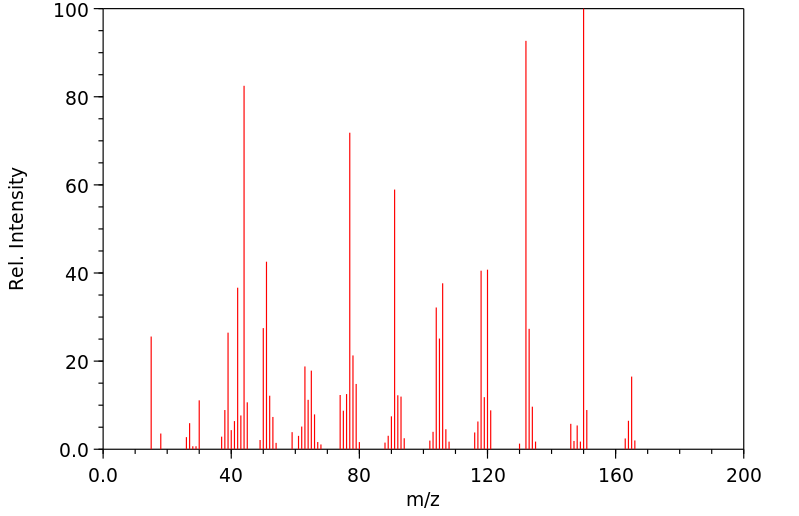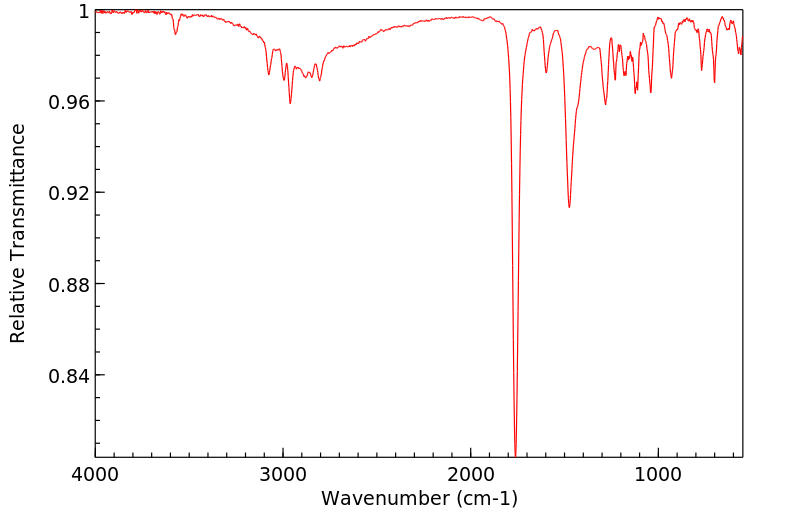2-二甲基氨基苯甲酸 | 610-16-2
中文名称
2-二甲基氨基苯甲酸
中文别名
2-二甲氨基苯甲酸
英文名称
N,N-dimethylanthranilic acid
英文别名
2-(dimethylamino)benzoic acid
CAS
610-16-2
化学式
C9H11NO2
mdl
——
分子量
165.192
InChiKey
DVVXXHVHGGWWPE-UHFFFAOYSA-N
BEILSTEIN
——
EINECS
——
-
物化性质
-
计算性质
-
ADMET
-
安全信息
-
SDS
-
制备方法与用途
-
上下游信息
-
文献信息
-
表征谱图
-
同类化合物
-
相关功能分类
-
相关结构分类
物化性质
-
熔点:71-72°C
-
沸点:293.03°C (rough estimate)
-
密度:1.1603 (rough estimate)
-
稳定性/保质期:
性质与稳定性:常温常压下,不会分解。
计算性质
-
辛醇/水分配系数(LogP):1.7
-
重原子数:12
-
可旋转键数:2
-
环数:1.0
-
sp3杂化的碳原子比例:0.22
-
拓扑面积:40.5
-
氢给体数:1
-
氢受体数:3
安全信息
-
TSCA:Yes
-
危险品标志:Xi
-
安全说明:S16,S24/25,S36/37,S45,S46,S59,S61,S9
-
危险类别码:R36/37/38
-
WGK Germany:3
-
海关编码:2922499990
-
包装等级:III
-
危险类别:6.1(b)
-
危险品运输编号:UN 2831 6.1/PG 3
-
危险性防范说明:P261,P305+P351+P338
-
危险性描述:H302,H315,H319,H335
-
储存条件:贮存: 将密封器密封,并储存在阴凉、干燥的位置。
SDS
上下游信息
-
上游原料
中文名称 英文名称 CAS号 化学式 分子量 2-二甲氨基苯甲酸甲酯 methyl 2-(dimethylamino)benzoate 10072-05-6 C10H13NO2 179.219 2-(N,N-二甲氨基)苯甲醛 2-(dimethylamino)benzaldehyde 579-72-6 C9H11NO 149.192 邻氨基苯甲酸 anthranilic acid 118-92-3 C7H7NO2 137.138 N,N-二甲基邻甲苯胺 N,N-dimethyl-o-toluidine 609-72-3 C9H13N 135.209 -
下游产品
中文名称 英文名称 CAS号 化学式 分子量 2-二甲氨基苯甲酸甲酯 methyl 2-(dimethylamino)benzoate 10072-05-6 C10H13NO2 179.219 N-甲基蒽 N-Methylanthranilic acid 119-68-6 C8H9NO2 151.165 2-(甲基氨基)苯甲酸乙酯 N-methyl-anthranilic acid ethyl ester 35472-56-1 C10H13NO2 179.219 1-[2-(二甲基氨基)苯基]乙酮 2'-(dimethylamino)acetophenone 10336-55-7 C10H13NO 163.219 —— 2-(dimethylamino)benzoic acid chloride 64109-38-2 C9H10ClNO 183.637 —— 2-(dimethylamino)benzohydrazide 86601-75-4 C9H13N3O 179.222 —— 2-(dimethylamino)-N,N-dimethylbenzamide 56042-97-8 C11H16N2O 192.261
反应信息
-
作为反应物:描述:2-二甲基氨基苯甲酸 在 双(乙腈)氯化钯(II) 、 氧气 、 copper diacetate 、 对甲苯磺酸 作用下, 以 N,N-二甲基甲酰胺 、 甲苯 、 乙腈 为溶剂, 反应 8.0h, 生成 吴茱萸碱参考文献:名称:钯催化的多步串联羰基化/ N-脱烷基化/羰基化反应:获得等位酸酐。摘要:通过钯催化的多步串联羰基化/ N-脱烷基化/羰基化反应,以烷基为离去基团,叔苯胺为氮亲核试剂,开发了一种新颖,高效的合成苯磺酸酐衍生物的方法。该方法具有良好的官能团相容性和易于获得的起始原料。此外,它为合成生物学和医学上有用的依夫二胺提供了一种方便的方法。DOI:10.1021/acs.joc.9b02771
-
作为产物:描述:参考文献:名称:Electrophilicity and nucleophilicity of commonly used aldehydes摘要:目前用于确定醛类电亲和性(E)和核亲和性(N)的方法包括对KMNO4氧化和NaBH4还原醛类的动力学研究。对KMNO4促进的醛氧化反应的过渡态分析表明,其与实验结果具有非常好的相关性。通过两种反应的实验活化参数验证了实验方法的有效性。通过理论与实验关系的进一步证明,该方法为各种醛类提供了便捷获取E和N值的途径,并能直观评估醛类在不同反应中的化学反应性。DOI:10.1039/c4ob00555d
文献信息
-
[EN] AZADECALIN DERIVATIVES AS INHIBITORS OF HUMAN IMMUNODEFICIENCY VIRUS REPLICATION<br/>[FR] DÉRIVÉS D'AZADÉCALINE EN TANT QU'INHIBITEURS DE LA RÉPLICATION DU VIRUS DE L'IMMUNODÉFICIENCE HUMAINE申请人:VIIV HEALTHCARE UK (NO 5) LTD公开号:WO2018002848A1公开(公告)日:2018-01-04Compounds having drug and bio-affecting properties, their pharmaceutical compositions and methods of use are set forth. In particular, azadecaline derivatives that possess unique antiviral activity are provided as HIV maturation inhibitors, as represented by compounds of Formula (I). These compounds are useful for the treatment of HIV and AIDS.
-
[EN] MODULATORS OF THE INTEGRATED STRESS PATHWAY<br/>[FR] MODULATEURS DE LA VOIE DE RÉPONSE INTÉGRÉE AU STRESS申请人:CALICO LIFE SCIENCES公开号:WO2017193063A1公开(公告)日:2017-11-09Provided herein are compounds, compositions, and methods useful for modulating the integrated stress response (ISR) and for treating related diseases; disorders and conditions.本文提供了用于调节综合应激反应(ISR)并治疗相关疾病、疾患和症状的化合物、组合物和方法。
-
Improved synthesis of sterically encumbered heteroaromatic biaryls from aromatic β-keto esters作者:Brandon R. Rosen、Ehesan Ul Sharif、Dillon H. Miles、Nicholas S. Chan、Manmohan R. Leleti、Jay P. PowersDOI:10.1016/j.tetlet.2020.151855日期:2020.5A protocol for the synthesis of hindered 4-aryl 2-aminopyrimidines from β–keto esters is described. The process employs trifluoroethanol as an essential additive to promote the guanidine condensation reaction, enabling the synthesis of 25 aryl- and heteroaryl substituted aminopyrimidines in good yields and high purities with no column chromatography. The conditions described herein are readily scalable
-
Acetic Acid Accelerated Visible-Light Photoredox Catalyzed<i>N</i>-Demethylation of<i>N,N</i>-Dimethylaminophenyl Derivatives作者:Guolin Wu、Yazhen Li、Xuemei Yu、Yu Gao、Haijun ChenDOI:10.1002/adsc.201601108日期:2017.2.20N,N‐Dimethylaminophenyl moiety is a common fragment in medicinal chemistry as several pharmaceuticals bearing this privileged motif are on the market and under clinical evaluation. Oxidative N‐demethylation is generally regarded as the major metabolic pathway. However, pharmacokinetics, metabolites studies as well as the further structural modification are precluded by the impracticality of chemical
-
A spectroscopic study of substituted anthranilic acids as sensitive environmental probes for detecting cancer cells作者:Adrian S. Culf、Huimin Yin、Susan Monro、Anirban Ghosh、David A. Barnett、Rodney J. Ouellette、Miroslava Čuperlović-Culf、Sherri A. McFarlandDOI:10.1016/j.bmc.2015.12.044日期:2016.3variation included: fluoro, trifluoromethyl, or cyano substitution on the aromatic ring, and derivitization of the parent carboxylic acid as esters or secondary carboxamides. Phenylboronic acid conjugation at the carboxylic acid alongside un-, mono-, and dimethylated 2-amino groups was also explored. The boron-containing anthranilic acids were also evaluated as sensitive fluorescent probes for cancer cells疾病状态的小分子荧光报道分子受到高度追捧,但仍然难以捉摸。邻氨基苯甲酸是极其敏感的环境探针,如果可以配备适当的靶向基团,它们有望作为癌细胞检测的通用但选择性试剂。一个小的N库的光学性质在甲醇和氯仿中研究了异丙基不变的邻氨基苯甲酸。变化点包括:在芳环上的氟,三氟甲基或氰基取代,以及将母体羧酸衍生为酯或仲羧酰胺。还研究了在羧酸上的苯硼酸共轭以及未,单和二甲基化的2-氨基。还使用激光扫描共聚焦显微镜评估了含硼邻氨基苯甲酸作为癌细胞的敏感荧光探针。通常,这些化合物产生的蓝色荧光受到取代和环境的强烈影响。事实证明,4-三氟甲基和4-氰基酯是最敏感的环境探针,在氯仿中的量子产率高达100%,从甲醇到氯仿的转化率提高了30倍。斯托克斯位移范围为63至120 nm,通常随着邻位取代和环境极性。结果表明,苯硼酸共轭是通过与过量表达的糖蛋白形成硼酸酯形成癌细胞的一种有吸引力的检测方法(不受正常,健康细胞的干扰
表征谱图
-
氢谱1HNMR
-
质谱MS
-
碳谱13CNMR
-
红外IR
-
拉曼Raman
-
峰位数据
-
峰位匹配
-
表征信息
同类化合物
(βS)-β-氨基-4-(4-羟基苯氧基)-3,5-二碘苯甲丙醇
(S,S)-邻甲苯基-DIPAMP
(S)-(-)-7'-〔4(S)-(苄基)恶唑-2-基]-7-二(3,5-二-叔丁基苯基)膦基-2,2',3,3'-四氢-1,1-螺二氢茚
(S)-盐酸沙丁胺醇
(S)-3-(叔丁基)-4-(2,6-二甲氧基苯基)-2,3-二氢苯并[d][1,3]氧磷杂环戊二烯
(S)-2,2'-双[双(3,5-三氟甲基苯基)膦基]-4,4',6,6'-四甲氧基联苯
(S)-1-[3,5-双(三氟甲基)苯基]-3-[1-(二甲基氨基)-3-甲基丁烷-2-基]硫脲
(R)富马酸托特罗定
(R)-(-)-盐酸尼古地平
(R)-(-)-4,12-双(二苯基膦基)[2.2]对环芳烷(1,5环辛二烯)铑(I)四氟硼酸盐
(R)-(+)-7-双(3,5-二叔丁基苯基)膦基7''-[((6-甲基吡啶-2-基甲基)氨基]-2,2'',3,3''-四氢-1,1''-螺双茚满
(R)-(+)-7-双(3,5-二叔丁基苯基)膦基7''-[(4-叔丁基吡啶-2-基甲基)氨基]-2,2'',3,3''-四氢-1,1''-螺双茚满
(R)-(+)-7-双(3,5-二叔丁基苯基)膦基7''-[(3-甲基吡啶-2-基甲基)氨基]-2,2'',3,3''-四氢-1,1''-螺双茚满
(R)-(+)-4,7-双(3,5-二-叔丁基苯基)膦基-7“-[(吡啶-2-基甲基)氨基]-2,2”,3,3'-四氢1,1'-螺二茚满
(R)-3-(叔丁基)-4-(2,6-二苯氧基苯基)-2,3-二氢苯并[d][1,3]氧杂磷杂环戊烯
(R)-2-[((二苯基膦基)甲基]吡咯烷
(R)-1-[3,5-双(三氟甲基)苯基]-3-[1-(二甲基氨基)-3-甲基丁烷-2-基]硫脲
(N-(4-甲氧基苯基)-N-甲基-3-(1-哌啶基)丙-2-烯酰胺)
(5-溴-2-羟基苯基)-4-氯苯甲酮
(5-溴-2-氯苯基)(4-羟基苯基)甲酮
(5-氧代-3-苯基-2,5-二氢-1,2,3,4-oxatriazol-3-鎓)
(4S,5R)-4-甲基-5-苯基-1,2,3-氧代噻唑烷-2,2-二氧化物-3-羧酸叔丁酯
(4S,4''S)-2,2''-亚环戊基双[4,5-二氢-4-(苯甲基)恶唑]
(4-溴苯基)-[2-氟-4-[6-[甲基(丙-2-烯基)氨基]己氧基]苯基]甲酮
(4-丁氧基苯甲基)三苯基溴化磷
(3aR,8aR)-(-)-4,4,8,8-四(3,5-二甲基苯基)四氢-2,2-二甲基-6-苯基-1,3-二氧戊环[4,5-e]二恶唑磷
(3aR,6aS)-5-氧代六氢环戊基[c]吡咯-2(1H)-羧酸酯
(2Z)-3-[[(4-氯苯基)氨基]-2-氰基丙烯酸乙酯
(2S,3S,5S)-5-(叔丁氧基甲酰氨基)-2-(N-5-噻唑基-甲氧羰基)氨基-1,6-二苯基-3-羟基己烷
(2S,2''S,3S,3''S)-3,3''-二叔丁基-4,4''-双(2,6-二甲氧基苯基)-2,2'',3,3''-四氢-2,2''-联苯并[d][1,3]氧杂磷杂戊环
(2S)-(-)-2-{[[[[3,5-双(氟代甲基)苯基]氨基]硫代甲基]氨基}-N-(二苯基甲基)-N,3,3-三甲基丁酰胺
(2S)-2-[[[[[((1S,2S)-2-氨基环己基]氨基]硫代甲基]氨基]-N-(二苯甲基)-N,3,3-三甲基丁酰胺
(2S)-2-[[[[[[((1R,2R)-2-氨基环己基]氨基]硫代甲基]氨基]-N-(二苯甲基)-N,3,3-三甲基丁酰胺
(2-硝基苯基)磷酸三酰胺
(2,6-二氯苯基)乙酰氯
(2,3-二甲氧基-5-甲基苯基)硼酸
(1S,2S,3S,5S)-5-叠氮基-3-(苯基甲氧基)-2-[(苯基甲氧基)甲基]环戊醇
(1S,2S,3R,5R)-2-(苄氧基)甲基-6-氧杂双环[3.1.0]己-3-醇
(1-(4-氟苯基)环丙基)甲胺盐酸盐
(1-(3-溴苯基)环丁基)甲胺盐酸盐
(1-(2-氯苯基)环丁基)甲胺盐酸盐
(1-(2-氟苯基)环丙基)甲胺盐酸盐
(1-(2,6-二氟苯基)环丙基)甲胺盐酸盐
(-)-去甲基西布曲明
龙蒿油
龙胆酸钠
龙胆酸叔丁酯
龙胆酸
龙胆紫-d6
龙胆紫








